 W
WGravity, or gravitation, is a natural phenomenon by which all things with mass or energy—including planets, stars, galaxies, and even light—are brought toward one another. On Earth, gravity gives weight to physical objects, and the Moon's gravity causes the ocean tides. The gravitational attraction of the original gaseous matter present in the Universe caused it to begin coalescing and forming stars and caused the stars to group together into galaxies, so gravity is responsible for many of the large-scale structures in the Universe. Gravity has an infinite range, although its effects become increasingly weaker as objects get further away.
 W
WThe Allais effect is the alleged anomalous behavior of pendulums or gravimeters which is sometimes purportedly observed during a solar eclipse. The effect was first reported as an anomalous precession of the plane of oscillation of a Foucault pendulum during the solar eclipse of June 30, 1954 by Maurice Allais, a French polymath who went on to win the Nobel Prize in Economics. Allais reported another observation of the effect during the solar eclipse of October 2, 1959 using the paraconical pendulum he invented. This study earned him the 1959 Galabert Prize of the French Astronautical Society and made him a laureate of the U.S. Gravity Research Foundation for his 1959 memoir on gravity. The veracity of the Allais effect remains controversial among the scientific community, as its testing has frequently met with inconsistent or ambiguous results over more than five decades of observation.
 W
WArtificial gravity is the creation of an inertial force that mimics the effects of a gravitational force, usually by rotation. Artificial gravity, or rotational gravity, is thus the appearance of a centrifugal force in a rotating frame of reference, as opposed to the force experienced in linear acceleration, which by the equivalence principle is indistinguishable from gravity. In a more general sense, "artificial gravity" may also refer to the effect of linear acceleration, e.g. by means of a rocket engine.
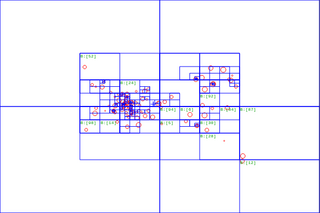 W
WThe Barnes–Hut simulation is an approximation algorithm for performing an n-body simulation. It is notable for having order O(n log n) compared to a direct-sum algorithm which would be O(n2).
 W
WThe gravitational binding energy of a system is the minimum energy which must be added to it in order for the system to cease being in a gravitationally bound state. A gravitationally bound system has a lower gravitational potential energy than the sum of the energies of its parts when these are completely separated—this is what keeps the system aggregated in accordance with the minimum total potential energy principle.
 W
WThe gravity of Earth, denoted by g, is the net acceleration that is imparted to objects due to the combined effect of gravitation and the centrifugal force.
 W
WThe Einstein–Hilbert action in general relativity is the action that yields the Einstein field equations through the principle of least action. With the (− + + +) metric signature, the gravitational part of the action is given as
 W
WThe European Low Gravity Research Association (ELGRA) is a non-profit international society devoted to the promotion of scientific research under various gravity conditions in Europe. The organization, established in 1979, provides a networking platform for all scientists interested in life and physical sciences and technology in space or on ground. ELGRA aims at representing and strengthening the scientific community of gravity-related research and helping young scientists and engineers get involved in low- and hyper-gravity research through educational programs.
 W
WIn Newtonian physics, free fall is any motion of a body where gravity is the only force acting upon it. In the context of general relativity, where gravitation is reduced to a space-time curvature, a body in free fall has no force acting on it.
 W
WGeneral relativity is a theory of gravitation developed by Albert Einstein between 1907 and 1915. The theory of general relativity says that the observed gravitational effect between masses results from their warping of spacetime.
 W
WGeomorphology is the scientific study of the origin and evolution of topographic and bathymetric features created by physical, chemical or biological processes operating at or near the Earth's surface. Geomorphologists seek to understand why landscapes look the way they do, to understand landform history and dynamics and to predict changes through a combination of field observations, physical experiments and numerical modeling. Geomorphologists work within disciplines such as physical geography, geology, geodesy, engineering geology, archaeology, climatology and geotechnical engineering. This broad base of interests contributes to many research styles and interests within the field.
 W
WThe gravitational constant, denoted by the letter G, is an empirical physical constant involved in the calculation of gravitational effects in Sir Isaac Newton's law of universal gravitation and in Albert Einstein's general theory of relativity.
 W
WGravitational energy or gravitational potential energy is the potential energy a massive object has in relation to another massive object due to gravity. It is the potential energy associated with the gravitational field, which is released when the objects fall towards each other. Gravitational potential energy increases when two objects are brought further apart.
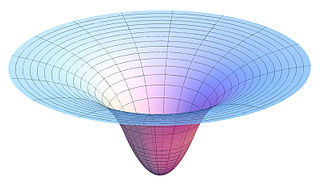 W
WIn classical mechanics, the gravitational potential at a location is equal to the work per unit mass that would be needed to move an object to that location from a fixed reference location. It is analogous to the electric potential with mass playing the role of charge. The reference location, where the potential is zero, is by convention infinitely far away from any mass, resulting in a negative potential at any finite distance.
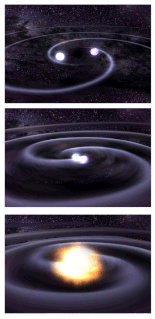 W
WGravitational-wave astronomy is an emerging branch of observational astronomy which aims to use gravitational waves to collect observational data about objects such as neutron stars and black holes, events such as supernovae, and processes including those of the early universe shortly after the Big Bang.
 W
WGravity feed is the use of earth's gravity to move something from one place to another. It is a simple means of moving a liquid without the use of a pump. A common application is the supply of fuel to an internal combustion engine by placing the fuel tank above the engine, e.g. in motorcycles, lawn mowers, etc. A non-liquid application is the carton flow shelving system.
 W
WIn orbital mechanics, decay is a gradual decrease of the distance between two orbiting bodies at their closest approach over many orbital periods. These orbiting bodies can be a planet and its satellite, a star and any object orbiting it, or components of any binary system. Orbits do not decay without some friction-like mechanism which transfers energy from the orbital motion. This can be any of a number of mechanical, gravitational, or electromagnetic effects. For bodies in low Earth orbit, the most significant effect is atmospheric drag.
 W
WLemaître coordinates are a particular set of coordinates for the Schwarzschild metric—a spherically symmetric solution to the Einstein field equations in vacuum—introduced by Georges Lemaître in 1932. Changing from Schwarzschild to Lemaître coordinates removes the coordinate singularity at the Schwarzschild radius.
 W
WIn mathematical physics, the Lemaître–Tolman metric is the spherically symmetric dust solution of Einstein's field equations. It was first found by Georges Lemaître in 1933 and Richard Tolman in 1934 and later investigated by Hermann Bondi in 1947. This solution describes a spherical cloud of dust that is expanding or collapsing under gravity. It is also known as the Lemaître–Tolman–Bondi metric or the Tolman metric.
 W
WLevitation is the process by which an object is held aloft, without mechanical support, in a stable position.
 W
WThe term micro-g environment is more or less synonymous with the terms weightlessness and zero-g, but with an emphasis on the fact that g-forces are never exactly zero—just very small. The symbol for microgravity, μg, was used on the insignias of Space Shuttle flights STS-87 and STS-107, because these flights were devoted to microgravity research in low Earth orbit.
 W
WThe acceleration due to gravity on the surface of the Moon is about 1.625 m/s2, about 16.6% that on Earth's surface or 0.166 ɡ. Over the entire surface, the variation in gravitational acceleration is about 0.0253 m/s2. Because weight is directly dependent upon gravitational acceleration, things on the Moon will weigh only 16.6% of what they weigh on the Earth.
 W
WIn physics, the n-body problem is the problem of predicting the individual motions of a group of celestial objects interacting with each other gravitationally. Solving this problem has been motivated by the desire to understand the motions of the Sun, Moon, planets, and visible stars. In the 20th century, understanding the dynamics of globular cluster star systems became an important n-body problem. The n-body problem in general relativity is considerably more difficult to solve.
 W
WIn physics and astronomy, an N-body simulation is a simulation of a dynamical system of particles, usually under the influence of physical forces, such as gravity. N-body simulations are widely used tools in astrophysics, from investigating the dynamics of few-body systems like the Earth-Moon-Sun system to understanding the evolution of the large-scale structure of the universe. In physical cosmology, N-body simulations are used to study processes of non-linear structure formation such as galaxy filaments and galaxy halos from the influence of dark matter. Direct N-body simulations are used to study the dynamical evolution of star clusters.
 W
WIn physics, an orbit is the gravitationally curved trajectory of an object, such as the trajectory of a planet around a star or a natural satellite around a planet. Normally, orbit refers to a regularly repeating trajectory, although it may also refer to a non-repeating trajectory. To a close approximation, planets and satellites follow elliptic orbits, with the center of mass being orbited at a focal point of the ellipse, as described by Kepler's laws of planetary motion.
 W
WIn physics, the Painlevé conjecture is a theorem about singularities among the solutions to the n-body problem: there are noncollision singularities for n ≥ 4.
 W
WPhysical geodesy is the study of the physical properties of the gravity field of the Earth, the geopotential, with a view to their application in geodesy.
 W
WIn physics, potential energy is the energy held by an object because of its position relative to other objects, stresses within itself, its electric charge, or other factors.
 W
WIn celestial mechanics, the Roche limit, also called Roche radius, is the distance from a celestial body within which a second celestial body, held together only by its own force of gravity, will disintegrate due to the first body's tidal forces exceeding the second body's gravitational self-attraction. Inside the Roche limit, orbiting material disperses and forms rings, whereas outside the limit material tends to coalesce. The Roche radius depends on the radius of the first body and on the ratio of the bodies' densities.
 W
WThe Schiehallion experiment was an 18th-century experiment to determine the mean density of the Earth. Funded by a grant from the Royal Society, it was conducted in the summer of 1774 around the Scottish mountain of Schiehallion, Perthshire. The experiment involved measuring the tiny deflection of the vertical due to the gravitational attraction of a nearby mountain. Schiehallion was considered the ideal location after a search for candidate mountains, thanks to its isolation and almost symmetrical shape.
 W
WSelf-gravity is the gravitational force exerted on a body, or a group of bodies, by the body(ies) that allows it/them to be held together. Self-gravity (self-gravitation) has important effects in the fields of astronomy, physics, seismology, geology, and oceanography. Self-gravity has important impacts in regard to the physical behavior on large scale objects, such as the oceans on Earth or the rings of Saturn. The equation to calculate the effects of self-gravitation were made exact by Lynden-Bell for the purpose of giving an exact description of models for rotating flattened globular clusters, which was a crucial step in understanding how clusters of stars interact with each other. Self-gravity deals with large-scale observations in fields outside of astronomy as well. Self-gravity does not typically appear as the central focus of scientific research, but understanding it and being able to include its effects mathematically increases the accuracy of models and understanding large-scale systems.
 W
WThe surface gravity, g, of an astronomical object is the gravitational acceleration experienced at its surface at the equator, including the effects of rotation. The surface gravity may be thought of as the acceleration due to gravity experienced by a hypothetical test particle which is very close to the object's surface and which, in order not to disturb the system, has negligible mass.
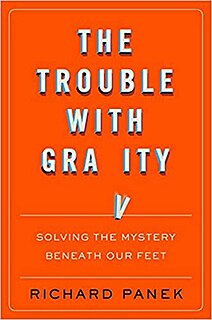 W
WThe Trouble With Gravity: Solving The Mystery Beneath Our Feet is a nonfiction popular science book by Richard Panek and published by Houghton Mifflin Harcourt on July 9, 2019.
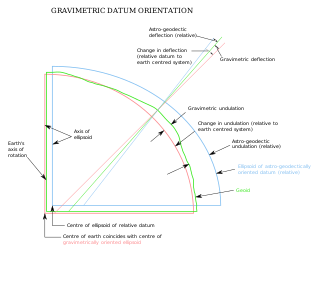 W
WThe vertical deflection (VD), also known as deflection of the plumb line and astro-geodetic deflection, at a point on the Earth is a measure of how far the gravity direction has been shifted by local mass anomalies such as nearby mountains. They are widely used in geodesy, for surveying networks and for geophysical purposes.
 W
WWeightlessness is the complete or near-complete absence of the sensation of weight. This is also termed zero-G, although the more correct term is "zero G-force". It occurs in the absence of any contact forces upon objects including the human body.
 W
WIn general relativity, the Weyl–Lewis–Papapetrou coordinates are a set of coordinates, used in the solutions to the vacuum region surrounding an axisymmetric distribution of mass–energy. They are named for Hermann Weyl, Thomas Lewis, and Achilles Papapetrou.
 W
WThe Woodward effect, also referred to as a Mach effect, is part of a hypothesis proposed by James F. Woodward in 1990. The hypothesis states that transient mass fluctuations arise in any object that absorbs internal energy while undergoing a proper acceleration. Harnessing this effect could generate a reactionless thrust, which Woodward and others claim to measure in various experiments.
 W
WA wormhole is a speculative structure linking disparate points in spacetime, and is based on a special solution of the Einstein field equations.
 W
WThe zero-velocity surface is a concept that relates to the N-body problem of gravity. It represents a surface a body of given energy cannot cross, since it would have zero velocity on the surface. It was first introduced by George William Hill. The zero-velocity surface is particularly significant when working with weak gravitational interactions among orbiting bodies.